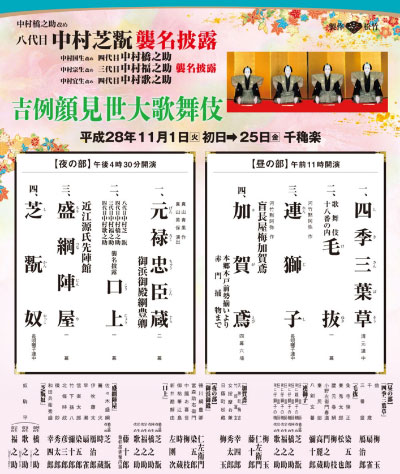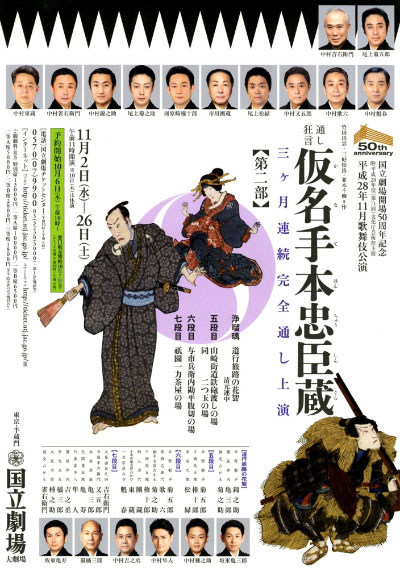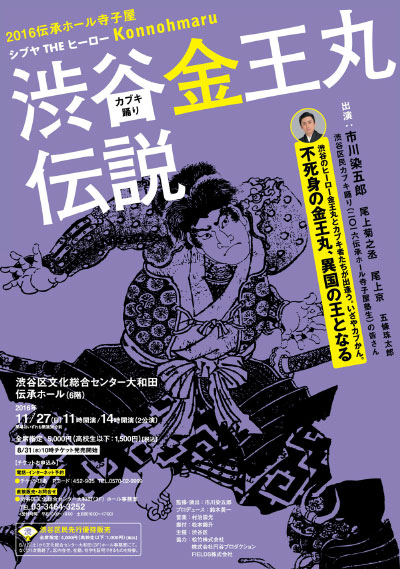| NOVEMBER 2016 |
| Kabukiza (T˘ky˘) |  |
| Dates | 1 ~ 25 November 2016 (Kichirei Kaomise ďkabuki) Annual Festive Face-Showing Grand Kabuki |
| MatinÚe |
Shiki Sanbas˘ |
| Evening |
Genroku Chűshingura |
| Casting |
Living National Treasure Sakata T˘jűr˘, Living National Treasure Kataoka Nizaemon, Nakamura Shikan, Matsumoto K˘shir˘, Nakamura Baigyoku, Nakamura Tokiz˘, Nakamura Ganjir˘, Nakamura Senjaku, Ichikawa Somegor˘, Ichikawa Sadanji, Kataoka Hidetar˘, Band˘ Yajűr˘, Band˘ Hikosabur˘, Onoe Matsuya, Ichikawa Monnosuke, Ichikawa Komaz˘, Nakamura Baishi, Nakamura Hashinosuke, Nakamura Fukunosuke, Nakamura Utanosuke |
| Comments |
Nakamura Shikan VIII and his three sons, Nakamura Hashinosuke IV, Nakamura Fukunosuke III and Nakamura Utanosuke IV, celebrated their second month of shűmei in T˘ky˘ at the Kabukiza.
|
 |
| National Theatre (T˘ky˘) |
| Dates | 2 ~ 26 November 2016 |
| Program |
|
| Casting |
Living National Treasure Onoe Kikugor˘, Living National Treasure Nakamura Kichiemon, Living National Treasure Nakamura T˘z˘, Nakamura Jakuemon, Onoe Kikunosuke, Nakamura Kaishun, Nakamura Kinnosuke, Ichikawa Danz˘, Onoe Sh˘roku, Nakamura Karoku, Nakamura Matagor˘, Kawarasaki Gonjűr˘, Arashi Kitsusabur˘, Band˘ Kamesabur˘, Band˘ Kametoshi, Nakamura Hayato, Nakamura Tanenosuke, Nakamura Kichinoj˘ |
| Comments |
Second month of the t˘shi ky˘gen production of the classic "Kanadehon Chűshingura" to celebrate the 50th anniversary of the opening of the National Theatre! The play "Kanadehon Chűshingura" (The Treasure of 47 Loyal Retainers) is the most popular in the Kabuki repertory and is known throughout the world.
|
 |
 |
|
|||
| Dates | 3 ~ 25 November 2016 (Jűichigatsu Hanagata Kabuki) November Young Actors Kabuki |
||
| Program |
Ishikawa Goemon |
||
| Casting |
Ichikawa Ebiz˘, Kataoka Takatar˘, Ichikawa Ukon, Nakamura Shid˘, Ichikawa En'ya, Ichikawa Emisabur˘, Kataoka Ichiz˘, Ichikawa Unosuke, Ichimura Kakitsu, Ichikawa Kudanji, ďtani Hiromatsu |
||
| Comments |
This drama was premiered in August 2009 at the Shinbashi Enbuj˘.
|
||
 |
| Eirakukan (Toyooka) |  |
| Dates | 4 ~ 11 November 2016 (Eirakukan ďkabuki) Eirakukan Grand Kabuki |
| Program | |
| Casting |
Kataoka Ainosuke, Kamimura Kichiya, Nakamura Kazutar˘, Nakamura Jűjir˘, Kataoka Senjir˘, Kataoka Senju |
| Comments |
This is the 9th Kabuki program at the Eirakukan, a renovated traditional theater built in the city of Toyooka (prefecture of Hy˘go).
|
| Sh˘chiku Kabuki Dance Tour | |
| Dates | 19 ~ 25 November 2016 (Sh˘chiku Kabuki Buy˘ K˘en) Sh˘chiku Kabuki Buy˘ Performances |
| Program |
Omemie Goaisatsu |
| Casting |
Kataoka Ainosuke, Kamimura Kichiya, Kataoka Sentar˘ |
| Comments |
A special 3-city (Matsuyama, K˘chi and Sendai) Autumn Kabuki Buy˘ tour sponsored by the Sh˘chiku!
|
|
|||
| Dates | 29 October ~ 3 November 2016 (Band˘ Tamasabur˘ Tokubetsu Buy˘ K˘en) Band˘ Tamasabur˘ Special Dance Performances |
||
| Program |
Aki no Irokusa |
||
| Casting |
Living National Treasure Band˘ Tamasabur˘ |
||
| Comments |
A special Buy˘ program starring the amazing Living National Treasure onnagata Band˘ Tamasabur˘ in Yamaga at the Yachiyoza, a traditional wooden-built theater.
|
||
| Kinshű Special Tour | |
| Dates | 7 ~ 25 November 2016 |
| Program |
Kabuki-juku |
| Casting |
Nakamura Kankur˘, Nakamura Shichinosuke, Nakamura Tsurumatsu, Nakamura Kosabur˘, Nakamura Ich˘, Nakamura Nakashir˘, Nakamura Nakanosuke, Sawamura Kunihisa |
| Comments |
The word kinshű means "Autumn Brocade". This Autumn tour stars Nakamura Kankur˘ and Nakamura Shichinosuke. The first item in the program is a speech/presentation on stage about some aspects of Kabuki.
|
| Shibuya-ku Bunka S˘g˘ Center ďwada (T˘ky˘) |  |
| Dates | 27 November 2016 |
| Program |
Shibuya Konn˘maru Densetsu |
| Casting | |
| Comments |
A newly-created Kabuki dance at the Shibuya-ku Bunka S˘g˘ Center ďwada. Ichikawa Somegor˘ shares the stage with the dance masters Onoe Kikunoj˘ III, Onoe Miyako and Goj˘ Tamatar˘. |
 |
|
|
| Contact | Main | Top | Updates | Actors | Plays | Playwrights | Programs | Links | FAQ | Glossary | Chronology | Illustrations | Prints | Characters | Derivatives | Theaters | Coming soon | News |
